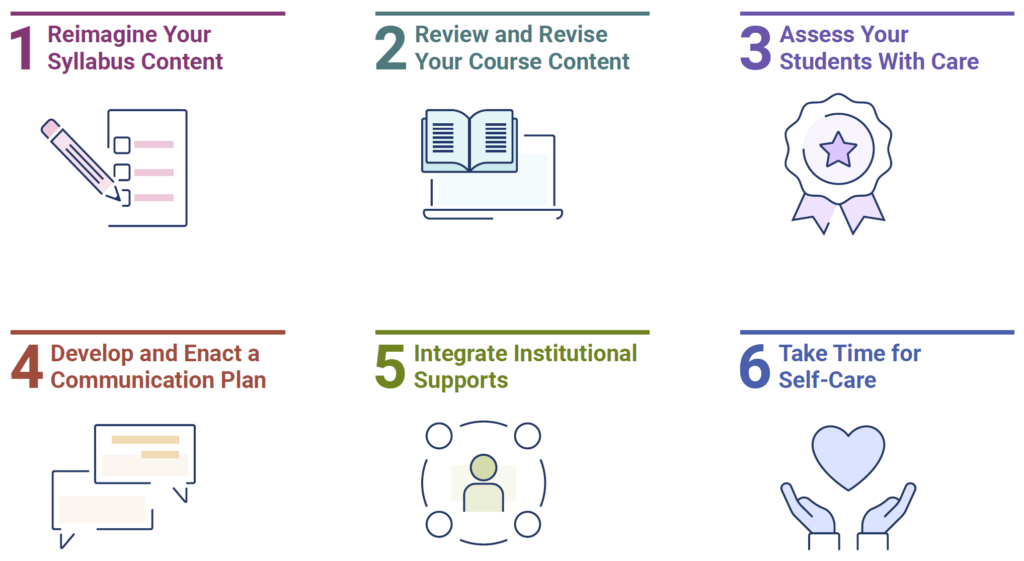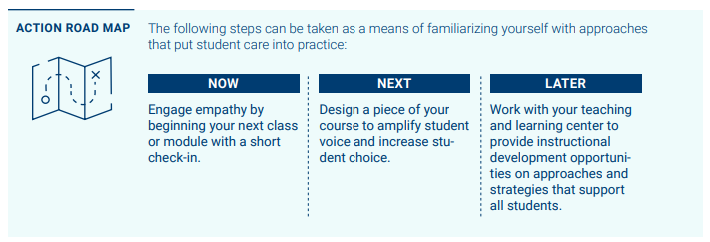Nicole Weber, Assistant Vice President of Learning at the Online Learning Consortium, says she and colleagues, reflecting on the last three semesters, felt that “while many educators have been exploring diversity, equity, and inclusion, this pandemic has really brought student challenges to the surface.”
Since the spring of 2020, academic programs have been under stress and educators have had to quickly learn to be effective in unfamiliar online and hybrid modalities. The challenges many students have always faced accessing and progressing in high-quality learning programs became more urgent.
Weber and her colleagues highlight that while there are many factors educators may not feel in control of, approaching course design with student care in mind is one way they create environments where success is achievable even in times of duress. With that in mind, the Online Learning Consortium, Achieving the Dream, and other members of the Every Learner Everywhere network developed a practical guide outlining proven and effective student-centered course design and teaching practices.
Now available for download, The Caring for Students Playbook focuses on “Six Recommendations for Caring for Students” and covers ways to operationalize equity-focused, inclusive teaching strategies that acknowledge student challenges while identifying student assets. A companion guide, Getting Started with Key Terms, Challenges, and Approaches published in late spring, provides in-depth discussion of the foundational concepts of a caring-centered approach.
The Caring for Students Playbook is organized around six recommendations that can influence course design and teaching. Each section includes several suggested action steps, prompt questions for reflection, practical resources, and student perspectives. The six recommendations are:
- Reimagine Your Syllabus Content
- Review and Revise Your Course Content
- Assess Your Students with Care
- Develop and Enact a Communication Plan
- Integrate Institutional Supports
- Take Time for Self-Care

Below are some highlights from the Playbook.
Reimagine your syllabus content
“The syllabus is often the first contact students have with the instructor,” Weber points out, so the tone and format of the syllabus influence how comfortable students will feel.
One example of a way to create a syllabus that is more welcoming and inclusive is to make finalizing it a collaborative process by putting it in a Google Doc so students can annotate it with questions and comments.
This interactive syllabus format is one of several alternatives introduced and illustrated in the Playbook, along with tools for evaluating your syllabus.
Develop and enact a communication plan
Weber says, “During the pandemic and navigating emergency remote instruction, we’ve really had to think about how to create instructor presence, how to create a connection between the instructor and the student, and how to create a connection between students.”
Remote learning requires special attention to developing and enacting a communication plan. For example, two tactics the Playbook outlines are an instructor video to greet students and a “Getting to Know You” survey.
In the survey, Weber recommends a question on “What I wish my teacher knew.” The goal of this question is to allow students to feel safe sharing personal or family issues they are balancing with their learning, and the Playbook teaches faculty how to honor these struggles and work with students to support them through difficult times.
Take time for self-care
Weber says faculty must protect their own well-being, because you can’t help others until you’re in a place where you can give help. “People have been going 100 miles an hour the last year,” she says. “Even though instructors have been trying to do the best they can, the possibility of burnout is very real.”
This recommendation includes ways to network with supportive peers and how to prioritize and respond effectively to requests. The recommended resources include the Mayo Clinic’s guide to spotting burnout and other reading on self-care for educators.
Laying the groundwork
The second part of the Playbook — Getting Started with Key Terms, Challenges, and Approaches — provides in-depth discussions of concepts necessary for caring-centered approaches to education, including:
- diversity, equity, and inclusion;
- culturally responsive teaching;
- trauma-informed teaching; and
- universal design for learning.
Each section includes background reading, example cases, and resources. For example, the section on culturally responsive teaching includes an interesting discussion on using cultural knowledge as a cognitive tool to support performance for minoritized students and goes on to recommend instruments to reflect on how culturally responsive your courses are.
What instructors should get out of the Playbook
Weber hopes instructors find tools for reflection and action in the Playbook. Because most instructors are already incorporating student care into their teaching, it may be a tool she says may help them realize, “‘Wow, I’m already doing this,’ and then to find ways to amplify or improve on what they’re doing.”
The Playbook is more of a cornucopia of resources than a recipe. Instructors will find a surplus of tools and recommendations to choose from.
Although the Playbook was born from the pandemic, Weber says the group working on it selected recommendations, strategies, and resources that apply in circumstances beyond the pandemic or emergency instruction. “One of the things we are hearing from students is ‘a vaccine is not going to cure my anxiety and depression,’” she explains. Problems with internet access and economic stressors won’t magically go away with the end of the pandemic.
“We need to continue to foster inclusivity and diversity and that looks different in different contexts,” she says. “There are no recipes, and there isn’t necessarily a ‘normal’ we’re going back to. We can’t slide back. We have to keep moving forward in caring for students. ”



